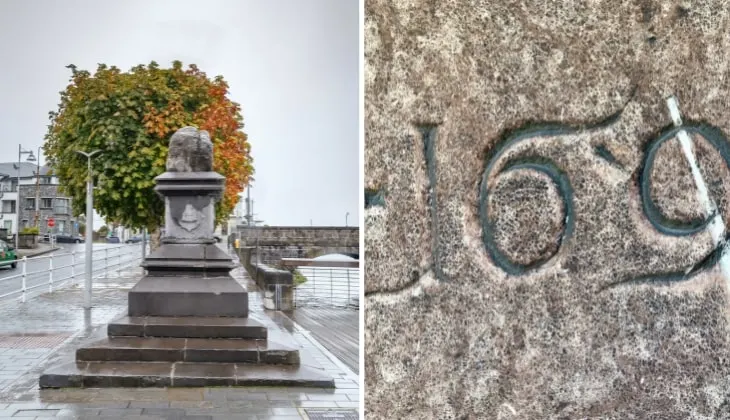The Treaty Stone in Limerick City is a good pit-stop.
It’s a short ramble from King John’s Castle and it’s tied to a key moment in the city’s rich history.
It was here that the Treaty of Limerick was signed which signalled the end of the Williamite-Jacobite War.
Below, you’ll find info on its history, its significance and where to visit close by.
Some quick need-to-knows about the Treaty Stone

Although a visit to the Treaty Stone in Limerick is fairly straightforward, there are a few need-to-knows that’ll make your visit that bit more enjoyable.
1. Location
The Treaty Stone is located in the heart of Limerick City on the bank of the River Shannon, next to Thomond Bridge. It’s a 5-minute walk from King John’s Castle, a 10-minute walk from St Mary’s Cathedral and a 15-minute walk from Thomond Park.
2. The treaty of Limerick
The Williamite-Jacobite War began in 1689 and continued until 1691 when the Treaty of Limerick was signed on the now-iconic Treaty Stone. This event marked the end of the war.
3. Signed in sight of both armies
The Treaty of Limerick was signed in the presence of both sides of the war on October 3rd, 1691.
4. A good pit-stop
It’s unlikely that you’ll spend long at the Treaty Stone, but it’s a good pit-stop en route to or from King John’s Castle. It’s also a short ramble from the likes of the Hunt Museum and St John’s Cathedral.
The story behind the Treaty of Limerick

Photos via Shutterstock
The Treaty of Limerick can cause a bit of confusion if you’re not familiar with the backstory.
So, I’m going to break it down in a way that’ll hopefully give you a good sense of what it was all about.
Now, please keep in mind that this is a speedy account of what happened, and does not give the full, very detailed account of the many events that took place.
How the Williamite War in Ireland came about
The Treaty of Limerick was signed on October 3rd, 1691. It’s signing marked the end of the Williamite War in Ireland.
Now, if you’re not familiar with this war, it was a battle between supporters of James II and supporters of William III.
How the conflict started
Well, William III (AKA ‘William of Orange’) deposed James II in what was known as the ‘Glorious Revolution’.
In a nutshell, in November 1688, James II, who was the king of England, Scotland and Ireland at the time, was forcibly removed from his throne and was replaced by his daughter, Mary II and her husband, William III.
Another key element of this war was the issue of land ownership and religion. James had a lot of support from Catholics in Ireland, as they believed he was their best chance of sorting out their issues.
The many battles
The war began in 1688 when the first clashes took place. The first major conflict that took place was the Siege of Derry, in 1689.
Soon after, in 1690, the Battle of the Boyne began near Drogheda, where William’s forces came out on top.
Limerick City came under attack twice – once, in mid-1690 and then again in 1691. The Jacobite supporters of James II surrendered in the second conflict.
In the summer of 1691, the Battle of Aughrim began and it was the bloodiest battle ever fought in the British Isles.
It’s estimated that between 5,000 and 7,000 people were killed during the conflict. James’s supporters were defeated and the army surrendered in Limerick in October after a second siege.
The signing
It was after the second Siege of Limerick that it was agreed that a Treaty would be signed. There were two sections to the Treaty; the first was to ensure that the conflict ceased and it was signed by the Irish Jacobites.
This resulted in the Flight of the Wild Geese – an event which saw an Irish Jacobite army transported to France.
The second part of the agreement related to those who remained. Part of the agreement was that Catholics would have religious freedom. Unsurprisingly, this was largely ignored.
Things to do nearby
One of the beauties of the Treaty Stone is that it’s a short spin away from many of the best places to visit in Limerick.
Below, you’ll find a handful of things to see and do a stone’s throw from the stone.
1. King John’s Castle (5-minute walk)

Photos via Shutterstock
King John’s Castle is located a stone’s throw (terrible pun, I know!) on the other side of the River Shannon. This ancient Norman castle dates back to the late 12th-century and through its long history has witnessed famines, sieges, battles and invasions.
2. Thomond Park (15-minute walk)

Photo by Fennel Photography via Failte Ireland
Thomond Park is located on Cratloe Road in the northwest of Limerick City. This stadium is the home of Munster Rugby. You can take a tour of the stadium and visit the on-site museum.
3. St Mary’s Cathedral (10-minute walk)

Photos via Shutterstock
St Mary’s Cathedral is located on Bridge Street and is the oldest building in Limerick still in use to this day. It features the only remaining pre-Elizabethan carved misericords in the whole of Ireland and is characterised by colourful stained glass windows and some magnificent architecture.
4. Lots more attractions in the city (15-minute +)

Photos via Myles Breens on FB
From the Hunt Museum and the Limerick City Gallery of Art to the many pubs in Limerick, the People’s Park and the endless restaurants in Limerick, you’ve plenty more to see and do.
